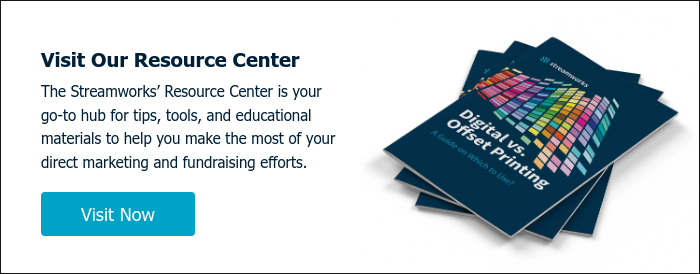How PURLs & Personalized QR Codes Elevate Direct Response Campaigns
Streamworks Blog
%20(1).jpg?width=1000&height=500&name=PURLBlogPhoto-(1)%20(1).jpg)
Personalization is the key to success in direct response acquisition, where the goal is to capture attention and prompt immediate action. Personalized URLs (PURLs) and Personalized QR Codes are powerful tools that bring relevance and ease to any campaign. These personalized digital touchpoints are designed to attract, engage, and convert new customers more effectively than generic links or codes. Each PURL or QR code is created specifically for the recipient, resulting in a unique PURL or unique URL that enhances personalization, tracking, and conversion rates.
Introduction to Direct Response Campaigns
Direct response campaigns are a powerful marketing effort designed to prompt immediate action from a carefully selected target audience. Unlike traditional marketing methods that focus on brand awareness, direct response campaigns aim to drive conversions—whether that means visiting a landing page, signing up for a service, or making a purchase. These campaigns often utilize direct mail, email marketing, and other marketing channels to deliver a compelling call-to-action directly to potential customers.
A key advantage of direct response campaigns is their ability to create a personalized experience. For example, a company might send a direct mail piece featuring a dynamic QR code that leads each recipient to a personalized landing page. This approach not only captures attention but also increases the likelihood of generating high quality leads. By leveraging multiple channels and customized content, businesses can create campaigns that resonate with their audience and drive measurable results. Ultimately, direct response campaigns help companies connect with customers in a meaningful way, making it easier to track engagement and optimize future marketing efforts.
1. Enhanced Personalization to Capture Attention
Personalization cuts through the noise in a world where consumers are bombarded with information. PURLs and personalized QR codes allow you to reach individuals on a personal level by incorporating their names, interests, or past behaviors directly into the response path. Imagine receiving a mailer with a QR code that leads to a webpage explicitly built for you—it’s more engaging. It shows an extra layer of thoughtfulness, adding a personal touch to the recipient's experience and helping create a stronger initial connection.
Using PURLs and QR codes, brands can create a personalized digital journey that feels unique and relevant. A personalized URL, for example, could be structured as “www.brandname.com/johnsmith” and lead John Smith directly to personalized landing pages crafted for him. This approach is proven to increase engagement rates, as recipients are more likely to engage with something that feels uniquely tailored to them.
2. Easier Tracking and Analytics
One of the most critical aspects of any direct response campaign is tracking its effectiveness. PURLs and personalized QR codes make monitoring each recipient’s journey simple. With these customized tools, you can collect valuable data, including:
-
Who scanned or visited the link.
-
When they interacted with it.
-
What actions did they take afterward.
Marketers can use UTM parameters and Google Analytics to track user behavior and gather valuable information about campaign effectiveness. These tools help analyze which channels drive engagement, how users interact with landing pages, and which actions lead to conversions.
This data provides immediate insights into campaign performance and audience behavior, enabling you to optimize future communications in real-time. For example, if certain demographics engage more frequently with specific content, you can tailor future campaigns to address those interests more directly.
3. Seamless User Experience with Personalized Landing Pages
PURLs and QR codes simplify the response process for recipients. By scanning a personalized QR code or clicking on a PURL, recipients are directed to a relevant landing page without needing to type URLs or remember complex instructions. This is an effective way to simplify the response process and increase engagement. This ease of use is incredibly impactful in mobile-first audiences, where a seamless journey from print to online can mean the difference between a successful lead and a lost opportunity.
Quick access also means that the recipient can instantly engage with offers, information, or other personalized content, leading to higher response rates.
4. Increased Conversion Rates with Contextual Relevance
PURLs and personalized QR codes also help to create contextual relevance, bridging offline-to-online experiences and bringing prospects into a digital space where they can take immediate action. According to research, personalized campaigns have conversion rates up to 10% higher than generic campaigns. When someone scans a QR code and lands on personalized landing pages, they’re more likely to take the next step—signing up for a service, completing a survey, or making a purchase—because the journey feels curated just for them, which positively impacts the overall conversion rate.
In addition, PURLs can be prefilled with relevant information, making the conversion process faster and more convenient. This reduces friction and boosts the likelihood of conversion. Tracking and analytics can measure key metrics such as website visits, helping marketers assess the effectiveness of their campaigns.
5. Flexibility and Adaptability Across Channels
PURLs and QR codes work seamlessly across direct mail, email, SMS, and more, making them highly adaptable for multi-channel campaigns. These tools can also be integrated with other channels such as social media and online ads to create a cohesive marketing strategy. In direct mail campaigns, QR codes can be included in physical mail pieces like flyers, postcards, and letters, encouraging recipients to explore additional content or claim an exclusive offer online. Static QR codes, which lead to a fixed URL, are less flexible than dynamic QR codes that can be updated or redirected without changing the code itself. SMS QR codes can be easily configured with a phone number and message for quick setup. This adaptability supports integrated marketing efforts by providing a simple bridge between offline and digital channels, ensuring consistent and personalized messaging across touchpoints.
6. Cost-Effectiveness with High ROI Potential
Given the relatively low cost of generating personalized URLs and QR codes, they provide an excellent return on investment. Using the right tools to create and track a successful marketing campaign can lead to higher ROI and better performance. Their ability to create high engagement and provide in-depth insights allows for more effective budget allocation in future campaigns. With data-driven insights from these tools, you can continuously refine your approach, ensuring each campaign yields more robust results.
Email Marketing Integration
Email marketing plays a vital role in the success of direct response campaigns. By integrating email marketing into their overall marketing strategy, businesses can reach their target audience with personalized and relevant messages that drive engagement and conversions. Email marketing allows companies to deliver customized content and exclusive offers directly to customers, guiding them to a specific landing page designed to maximize response rates.
For instance, businesses can use automation tools to create targeted email campaigns that direct recipients to a specific landing, making the process easier and more efficient. This personalized approach not only increases the chances of conversion but also enhances customer engagement by providing content tailored to individual preferences. When combined with direct mail marketing, email marketing creates a multi-channel strategy that reinforces messaging across different platforms, ensuring a cohesive and impactful customer experience. By leveraging both channels, companies can create more meaningful interactions and drive conversions more effectively.
Customer Lifetime Value
Customer lifetime value (CLV) is a crucial metric for any business looking to maximize the impact of its marketing efforts. CLV measures the total value a customer brings to a company over the course of their relationship, helping businesses identify and prioritize their most valuable customers. By understanding customer behavior and preferences, companies can create targeted marketing campaigns that foster loyalty and increase customer lifetime value.
Data collection and analysis play a significant role in this process. With tools like dynamic QR codes and personalized URLs, businesses can track how customers interact with their campaigns across multiple platforms. This data-driven approach provides valuable insights into customer preferences, enabling marketers to tailor their messaging and offers for maximum impact. By focusing on high-value customers and delivering personalized experiences, companies can improve retention, boost customer lifetime, and make smarter decisions about where to invest their marketing resources. Ultimately, leveraging CLV helps businesses create more effective marketing strategies and achieve better long-term results.
Final Thoughts
In today's digital age, direct response acquisition campaigns that incorporate PURLs and personalized QR codes are set up for success. By creating a seamless, relevant, and highly trackable experience, these tools enhance the recipient's journey and give brands the insights needed to tailor future strategies effectively. Whether aiming to boost engagement, simplify tracking, or improve conversion rates, adding PURLs and personalized QR codes to your acquisition strategy is a proven way to make a lasting impact.



.jpg?width=352&name=Appeal-Letter-Writing%20(1).jpg)
